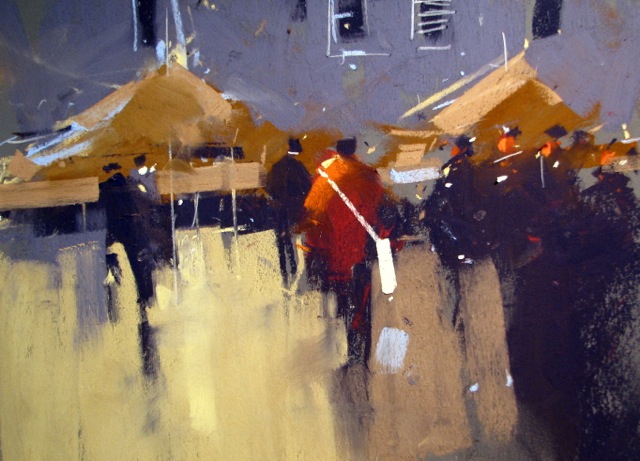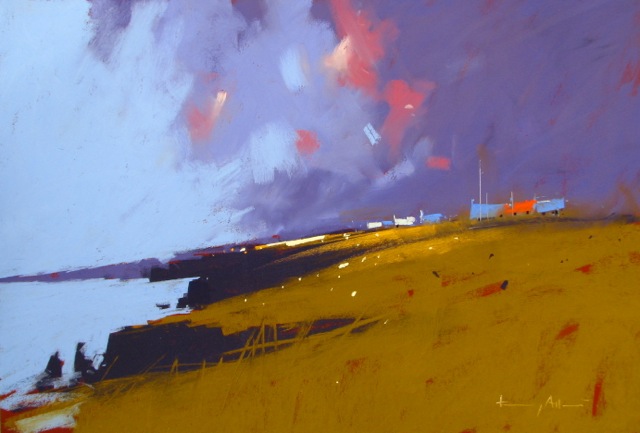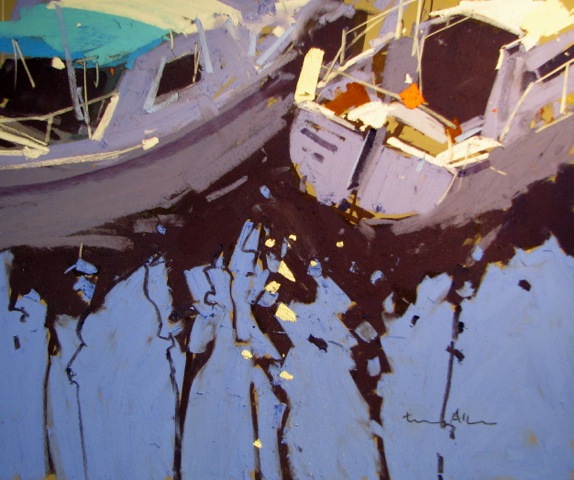The Artspan blog has moved!
Please visit: https://artspanart.wordpress.com to continue following our posts.

The Artspan blog has moved!
Please visit: https://artspanart.wordpress.com to continue following our posts.
This week, Tony Allain talks to us about subject matter, inspirational artists and one particular work he is most proud of.

What attracts you to pastel as a medium for your paintings?
When I first started painting, forty or more years ago I was a tonal painter in watercolour and oil generally sticking to the more sedate earth and ochre colours. It was less than twenty years ago that I was introduced to soft pastel by an artist friend who lead me into the world of ‘pure pigment on a stick’. As colour and light are the motivation for me to paint pastel gives me the vehicle to satisfy my appetite to record the world as I see it now in colour, light, form and shape. Pastel is immediate, very portable and can be done equally successful plein air or in the studio.
What types of subject matter do you find most resonant with your creative ideas?
Colour and light are my motivation for choosing a subject. The light sparkling on the water, the colour reflected in the landscape. I favour the mood of the early morning or late afternoon. There is no finer feeling than to be presented with a wealth of subject matter, literally on ones doorstep.

Which is more important to you, the subject of your painting, or the way it is executed?
Both are very important factors for me to make a panting. My aim is to try and simplify the scene into a few big shapes (perhaps half a dozen at most); those shapes are not simply blocks of one colour, very often they are areas of broken colour, sometimes mixing colours that are tonally very close, so that the effect is quite subtle; I restrict the palette used in any given painting. I am happy to exaggerate the colours for the sake of making a painting, quite often you I use a lot of neutral or dark colours, then use bright colours to draw attention to the focal point of the picture
I aim to keep it simple throughout most of the passages. I block in several lean layers. This allows me to glaze and blend colours to the desired colour, shade and tone I am looking for. I do very little ‘finger blending’. For example, to warm up an area of mostly green fields, I will lightly ‘brush’ in an underpainting of an orange/gold colour. It seems to work for me. As Degas once said, “drawing/painting is not about what one sees. It’s about what one makes others see”.
What projects are you working towards at the moment?
I have several projects on the go at the moment. I have at least one solo or group exhibition each year at various galleries. I am a member of The Pastel Society, UK, the Pastel Society of America and the Pastel Artists of New Zealand this allows me entry into all three of their annual exhibitions. I also run workshops and demonstrations for art groups and societies at home and overseas.
Are there any artists who particularly inspire you?
Yes. The American pastel and oil painter Jennifer Evenhus. She paints both large and small format oils. Her work is contemporary impressionism and sometimes very abstract. Her large oils will dominate a room with their colour and dynamic composition. Her small oils are tiny treasures of beautiful colour and bold brushstrokes. Jennifer’s pastels are equally colorful and full of emotion with exciting and direct confident marks.

Is there an artwork featured on your Artspan website that you are most proud of? Why?
Yes the painting on my home page (Marina Reflections, pictured). This painting was done from on the spot colour sketches. The reflections were the main attraction for me. This painting was done fairly quickly within a two hour period. I was particularly pleased with the overall tone and almost monochromatic effect. I am also happy that nearly every mark and passage that makes up this piece. My goal is always to make a mark and never touch it again – This is what happened with this painting.
View Tony’s Artspan website HERE
Almost all internet exposure is important, but your promotional efforts should have a focal point on the web and that focal point should be an individual professional website. Artists Georgia Peskett and Susan Sluglett yesterday offered their advice to graduating artists at Cass Art’s Free Thinking event, part of Free Range at the Truman Brewery on London’s Brick Lane.
Some tips:
Why Artspan?
Artspan is offering recent graduates a free trial!
Sign up by 20th July and use code PH17 for a three month free trial:
START FREE TRIAL
“I paint and draw exclusively from life. My work is autobiographical and focused on the human figure. Painting must be – for me – some kind of translation of psychological experience.”
View more of Slawek’s work on the Artspan website HERE.
In a second article, this time for Arts Professional, Eric Sparre warns that although online sales of art may have grown significantly in the past year, artists and galleries must work hard to attract a digital audience.
“Artists must be actively involved in promoting their careers and selling their work online. This is really no different from any time in the past – successful artists have generally been active in their own cause. The internet has to be effectively used by artists, and when it is, there is no greater medium for reaching out to both existing and potential collectors. There has never been a tool like it for advancing careers and selling art.”
Read the full article on Arts Professional HERE
An article written for Arts Industry’s June issue, now on sale.
Eric Sparre, Director of Artspan, the site which combines branded sites with an online gallery, argues that for visual artists, the internet is taking up where commercial galleries leave off. However, the two can work together
Once upon a time, establishing a career seemed a simple matter for visual artists. First: secure gallery representation. Then: back to the studio. Let the gallery worry about sales, which were sure to come and at steadily increasing prices.
Of course, the process was never that simple. Then, as now, dealers were often reluctant to take on new artists. But with no serious alternative, most working artists had no choice other than to keep knocking on the same doors. And even with representation, there was no guarantee of success: galleries could control client lists, veto outside opportunities, hold payments on sales, and dictate the extent of publicity. For artists without representation, particularly older artists, prospects were even bleaker.
The advent of the Internet has brought empowerment. Alongside social media, artists now use the web in two main ways: by creating personal, branded websites to promote their work as they please, and by using online galleries to show work for sale, joining other artists and/or makers (Saatchiart and Etsy are prominent examples of online galleries).
The problem of encouraging traffic to self-managed artist websites is a very real one. There are hundreds of millions of results for a Google search on “artist.” As for online galleries, while artists may have an individual profile page, that page will not have its own domain name and is therefore limited in its promotional outreach. Sales are essentially one-offs.
Artspan is the only provider of templated websites to combine independent branded sites with an online gallery. This concept grew out of my experience setting up my own artistic website in 1996. I commissioned a developer to build a website, but this proved costly and took far too long to complete. The end result was a website reflecting the developer’s design sense but not mine. Since I did not yet know how to code and was not even confident uploading images, there was little I could do with the site. Also, it was competing for traffic, and I had no idea how to boost visitor numbers.
It was this experience which shaped Artspan at its beginnings in 1999, and continues to inform it today. I assumed a lot of artists would be in the same situation as myself: light on tech and web skills. I therefore wanted to offer artists self-managed, independently branded websites with their own domain names, while also making these sites part of a larger artist community. I realised that a community of websites would be much more likely to attract traffic than any individual website.
Of course, our member websites have incorporated many tech advances in the years since. The features are much more developed and include e-commerce functions. Artists can customise the look of their sites, and the social media and search engine optimisation (SEO) tools greatly extend their potential reach. They are also tailored to a visual artist’s specific needs – grouping images and image details in distinct galleries and offering such options as multiple views of artwork.
Each website is intended to serve as the focal points for the artist’s promotion, and as virtual studios where collectors and others can keep abreast of an artist’s work. Importantly, each site can be used to sell artwork with no commissions due when buyers go directly to the artist’s site.
The recently re-launched UK version of the community site, Artspan.co.uk, combines content with search features and directories. The Search+Shop functions ensure that search results are truly relevant. Featured are both original works and (giclee) Prints-on-Demand. Clicking on any thumbnail in the search results pages brings up a ‘Product Page’. This page gives the visitor details about the artwork, the artist, and shows thumbnails of their other work, functioning as a mini-site similar to the profile pages of other online galleries, but here the visitor can click through to the independent artist website. To attract visitors and build traffic to our member websites, we also feature artwork in our Articles and Collections, and on our blog and social media platforms.
We facilitate sales but are not dealers (our highest commission is 10%). Instead, we partner with artists, providing tools, visitors, and easy ways for visitors to find artwork. Being an artist myself, it was important to me that we also foster an expanding, vital, international community. American buyers have recognized that UK artists have unique visions and strong skills and their work should be easily accessible to North American buyers and art consultants. Artspan aims to stimulate this interest. Our prints-on-demand targets a growing US market for affordable prints. And we plan a new outreach to art consultants who will have their own destination under another domain, dARTresources.com.
Finally, returning to the matter of establishing a career. Physical galleries continue to play a pivotal role but are themselves increasingly moving online with an ever larger proportion of their business coming from their websites. They may see additional opportunities in working with an Internet company such as Artspan. We could host their artists’ websites (linking back to the gallery) and attract buyers that a physical gallery might not have access to. We would work to protect any arrangement the gallery might have with an artist. Further, galleries can (and do) use Artspan to source artists.
Marketing art does not have to be a zero-sum game. We should all be able, where it is feasible, to work together to expand the market. And opportunities for artists.
Jewellery does not need to be only a pretty adornment, it can be so much more. It’s like creating an art work, but on a very small scale. I give a lot of thought to every single piece carefully choosing the theme. “Looking into London” is a ring from my Architectural Collection. My main objective is to catch the essence and potential of the particular place and tell the viewer a story. My design process has few stages: first I collect information about a city/building, and then I try to pay a visit to a place. It’s only with these preparations that I’m able to express what I feel about a particular area.
“Looking into London” is inspired by London’s architecture. The reflections of the landmarks appear on the silver disc in the middle, like in the River Thames which flows through the centre of London. Main landmarks were hand carved and cast in silver. The landmarks are easily recognisable to the viewer: Big Ben, St. Paul’s Cathedral, Tower Bridge, Westminster Abbey and the Gherkin.
See more of Agnieska’s work on the Artspan website HERE.
I spotted this tree just outside of Stafford, England. I was taken by the oaks’ age, textures and visual impact. The light on it was extraordinary, which was further enhanced by the wet surfaces.
I endeavoured to put a feeling of motion to the composition, enhancing the flowing, upward growth thrust of the trunk. The bark and its occasional absence also emphasised the massiveness and presence of the ancient oak. This picture is also about time. The oak is centuries old. It has lived so long the centre of the trunk has rotted away, leaving the characteristic twin sections. The passing storm has had its own time frame, perhaps passing in an hour or so. Finally the water dripping from the centre of the bark is happening in the blink of an eye. Although I also do portraits and abstracts, I continue to be fascinated by the effects of light in nature. On my websites you can see that I have tried to capture the various moods and lighting conditions of beaches, woods and the countryside.
I will continue to explore how things work visually when light is bounced off them. Textures also interest me, as evident in my abstracts, which are very tactile and stimulating to the sense of touch. Plenty to go at then!
See more of Mark’s work on the Artspan website HERE
This painting was inspired by the view from my sister’s flat in the centre of Amsterdam: a familiar scene to me transformed by snow. The longer I looked at it the more colours I could see, and I liked the perspective – looking down and across to windows blurred from view from the snowstorm, also the perspective of the snow itself; the large flakes drifting across the vision close-up, to the haze in the distance.
One of the challenges with this painting was to convey the feeling of intimacy implied by the half-shuttered and curtained windows, with the contrast of the rawness and cold of the snow. Using oils – my preferred medium – helped me in this by being able to move paint across the surface and ‘lose’ edges where the snow had fallen and partly obscured buildings etc.
I used a fairly limited (and mainly) earth palette: Cerulean Blue, French Ultramarine, Burnt Sienna, Burnt Umber, Raw Umber, Raw Sienna, Yellow Ochre and Flake White. The latter is getting harder to get hold of and I am not sure what I’d do without it! It’s much softer and less chalky and intense than Titanium White (great for highlights) and underpins the muted tones in this painting.
See more of Alison’s work on her Artspan website HERE
Strange Faces: Masked, Distorted, Dissipated, Hidden
The newest gallery up on artspan.co.uk explores ‘Strange Faces’ and features two UK artists, Lee Furlong and Cary Lee. CLICK HERE to view the full gallery.
